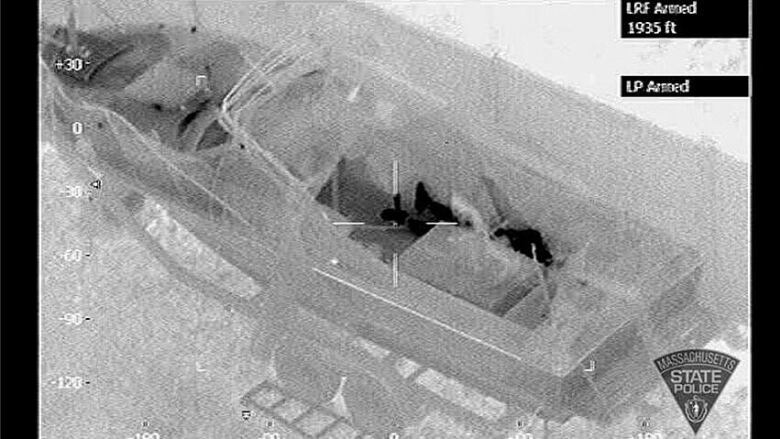How infrared cameras helped end Boston manhunt
Camera found Dzhokhar Tsarnaev on boat under tarp

One of the high-tech tools that helped police capture the suspect in the Boston Marathon bombing was an infrared camera that can see through materials such as plastic.
The search for Dzhokhar Tsarnaev was one of the biggest manhunts in U.S. history, and ended Friday night when police found him hiding in a boat parked in a backyard in Watertown, Mass.
Responding to a tip from the boat owner himself, police used an infrared camera on a helicopter to confirm that Tsarnaev was actually in the boat.
The incriminating black-and-white image was released over the weekend, and news watchers were amazed that a camera could capture such a lucid photo of someone hiding under a tarp at night.
How it works
Every object emits heat, but infrared radiation is below the level on the light spectrum that human eyes are able to see.
An infrared camera, however, can detect those wavelengths in this case, the warm body of Tsarnaev and translate them into wavelengths that human eyes can see.
"The camera that took that particular image would have been using a wavelength in between three to five micron wavelengths, and thats very different from what our eyes can see, which is down around one to 0.4 micron wavelengths," says Rob Milner, science and automation manager for FLIR Systems Canada, which manufactures infrared thermal imaging cameras.
Infrared cameras produce images that highlight the hottest object in the frame, typically as white or black. In the now-famous aerial shot from the weekend, the dark outline of Tsarnaevs body right down to his socks is visible tucked in on the right side of the boat, even though the craft was covered by a tarpaulin.
"That guy was lying in the boat, giving off heat and bleeding, as I understand it," says Jeffrey Lebold, a thermographer based in Oshawa, Ont.
"He would be causing an infrared thermal pattern on the tarp of that boat, so when they shine the camera onto the boat, they could see the thermal radiation being radiated from his body inside the boat."
Infrared has both military and civilian uses
News watchers have marveled at the crispness of the image that led to Tsarnaevs capture, but thermal imaging is by no means new technology.
Infrared cameras have been around since the 1950s, used in everything from military applications to disease detection. FLIR Systems created the first commercial infrared camera in 1960.
Jeffrey Lebolds company, Boldstar Infrared Services, uses infrared cameras in home and building inspections to find problems such as hidden electrical issues and heat loss. He says the pictures they shoot arent as vivid as those taken with consumer cameras, but the technology is constantly improving.
"Infrared cameras arent up there with digital cameras in terms of megapixel images, but theyre slowly getting better as far as the resolution goes," says Lebold.
Because they specialize in finding hidden sources of heat, infrared cameras are often used by law enforcement to find marijuana grow ops.
Milner said that while the cameras are a great detection tool, law enforcement officials were lucky this past weekend in the fact that the tarp that obscured Dzhokhar Tsarnaev was made of a synthetic material.
"The light plastics in a tarpaulin are transparent to certain infrared cameras," Milner said.
The cameras can't "see" heat signatures through thick materials such as walls or, ironically, glass. Milner pointed out that had the boat been covered with a giant piece of plywood or even a tarp made of natural fibres, "it would not have been transparent" to the camera.












_(720p).jpg)


 OFFICIAL HD MUSIC VIDEO.jpg)
.jpg)



























































































